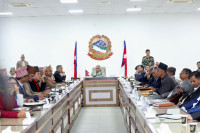National
Human-animal conflict: Ayodhyapuri buffer zone residents live in terror
Since 1998, as many as 28 people have been killed in wildlife attacks in the area close to Chitwan National Park.
Ramesh Kumar Paudel
Ayodhyapuri, spread in wards 7, 8, and 9 of Madi Municipality, is surrounded by the Chitwan National Park (CNP) and Someshwar forest on three sides. There are eight settlements in the Ayodhyapuri area.
Unfortunately, Ayodhyapuri has come to be known for human-animal conflict, causing loss of lives and properties each year. As many as 28 people have been killed in wildlife attacks there since 1998.
On March 20, 2004, Rajendra Neupane, a local from the eastern border of Ayodhyapuri, went to the Someshwar hill to the south with his son-in-law, Madhav Adhikari, and three other friends.
It turned out to be a “black day”, Neupane said. “A tiger attacked us in the forest,” he said. “Four of us were killed. I somehow managed to flee and survived.”
Binita Bhandari, another local of Ayodhyapuri, said that on November 27, 2009, she and her two neighbours were collecting dry grass and firewood in Someshwar hill, when a wild elephant attacked them.
“I luckily survived, but my two neighbours were brutally killed,” Bhandari said. “The memory of the incident remains indelible in my mind.”
Many people have been attacked by tigers, rhinos, wild elephants and other wild animals in the Ayodhyapuri Buffer Zone Area of Chitwan National Park, which covers some areas in wards 7, 8 and 9 of Madi Municipality. According to Shivaji Gayak, president of the Ayodhyapuri Buffer Zone Consumer Committee, 28 people have died since 1998. As many as 15 people have been killed by tigers; nine by wild elephants; two by a rhinoceros; and one each by a bear and wild boar.
Ayodhyapuri, with about 2,500 households, has seen many deaths and countless injuries over the years. After the formation of the Ayodhyapuri Buffer Zone Consumer Committee in 1997, the process of keeping details of locals and animals was started in 1998. Since then 46 people have been injured in Ayodhyapuri in wild animals’ attacks.
Bigu Bote, another local of Ayodhyapuri, says he was attacked and maimed by a bear near his house some 30 years ago, confining him to a wheelchair now.
“After the attack, my spinal cord was broken, and I was paralysed from the waist down,” Bote said. “People here are not safe even in their houses. They are afraid to go outside, no matter the urgency, due to the terror of wild animals.”
According to him, more than 30 people in Ayodhyapuri are living with disabilities after being attacked by wild animals.
According to Chitwan National Park, there are 21 consumer committees and one subcommittee concerning the Park, which covers East Nawalparasi (Bardaghat Susta), Makwanpur, and Parsa districts along with Chitwan.
Dil Bahadur Purja Pun, chief conservation officer in Chitwan, said that after the establishment of the buffer zone committee, 252 people have died and 865 injured in the forests overseen by these 21 committees.
“More than inside the park, incidents of wild animal attacks have become a big problem around it,” Pun said. “Due to some recent efforts, the incidents have gradually reduced in Ayodhyapuri.” There are around 93 tigers in the park area.

“The latest incident of human casualties was on April 27, 2022, when a local man was killed by a tiger near Ayodhyapuri. However, there have been several injuries and destruction of property since,” said Pun.
Madi Municipality has some of the oldest settlements in Chitwan, with the majority of the tribal Tharu community. But Kalyanpur and Ayodhyapuri are new settlements, growing after 2022.
“In the area, residents are afraid to rear cattle or any livestock due to the fear of wild animals. Animals damage crops and fields more often. People skip nature’s call at night,” said Amrit Ranabhat, another resident of Ayodhyapuri.
According to Shivaji Gayak, president of the Chitwan National Park buffer zone area council, the locals have managed to live with the other wild animals, but the main problem is the tigers.
In recent times, the numbers of tigers and rhinos have increased, Gayak said. “It’s very hard to avoid encounters with them, despite our precautions,” he said. “There is a need for fences and walls around Ayodhyapuri as there is currently only a 600-metre fence. In order to protect the village and its residents, a 6-kilometre-long fence is needed around the buffer zone.”
Incidents of human-animal conflict are unchecked with an ever-increasing number of wild animals like tigers and rhinos.
According to data from the Department of National Parks and Wildlife Conservation, there were 121 tigers in Nepal in 2009. The number has almost tripled to 355, according to the tiger census 2022. Chitwan is home to 128 tigers, according to the 2022 census. The census of 2018 showed Chitwan National Park had 93 tigers.
Similarly, the rhino population has also increased in Chitwan National Park. According to the national rhino census conducted in 2021, Nepal is home to 752 one-horned rhinos, with Chitwan National Park alone hosting 694 of them. The country’s rhino population stood at 645 in 2015, with 605 rhinos in Chitwan alone.




 8.12°C Kathmandu
8.12°C Kathmandu1.jpg)





.jpg&w=200&height=120)









